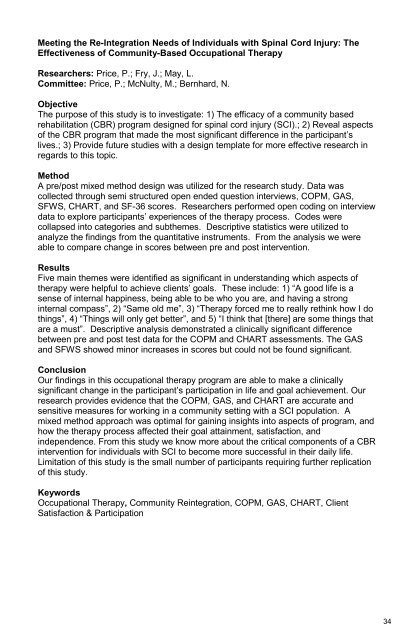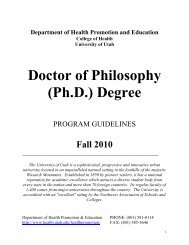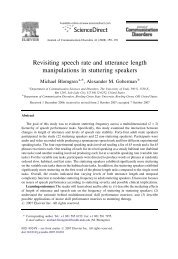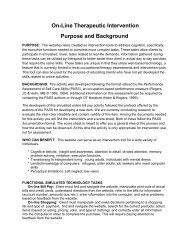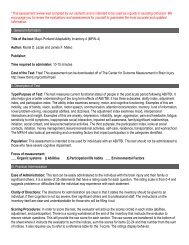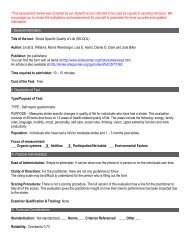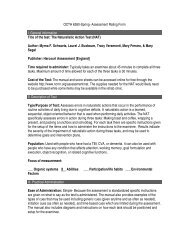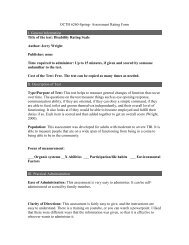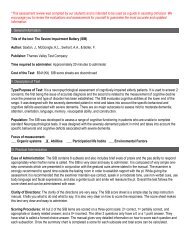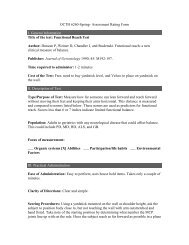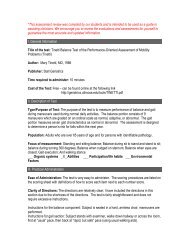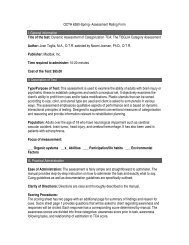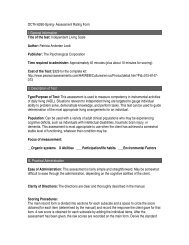Meeting the Re-Integration Needs <strong>of</strong> Individuals with Spinal Cord Injury: The Effectiveness <strong>of</strong> Community-Based Occupational Therapy Researchers: Price, P.; Fry, J.; May, L. Committee: Price, P.; McNulty, M.; Bernhard, N. Objective The purpose <strong>of</strong> this study is to investigate: 1) The efficacy <strong>of</strong> a community based rehabilitation (CBR) program designed for spinal cord injury (SCI).; 2) Reveal aspects <strong>of</strong> the CBR program that made the most significant difference in the participant’s lives.; 3) Provide future studies with a design template for more effective research in regards to this topic. Method A pre/post mixed method design was utilized for the research study. Data was collected through semi structured open ended question interviews, COPM, GAS, SFWS, CHART, and SF-36 scores. Researchers performed open coding on interview data to explore participants’ experiences <strong>of</strong> the therapy process. Codes were collapsed into categories and subthemes. Descriptive statistics were utilized to analyze the findings from the quantitative instruments. From the analysis we were able to compare change in scores between pre and post intervention. Results Five main themes were identified as significant in understanding which aspects <strong>of</strong> therapy were helpful to achieve clients’ goals. These include: 1) “A good life is a sense <strong>of</strong> internal happiness, being able to be who you are, and having a strong internal compass”, 2) “Same old me”, 3) “Therapy forced me to really rethink how I do things”, 4) “Things will only get better”, and 5) “I think that [there] are some things that are a must”. Descriptive analysis demonstrated a clinically significant difference between pre and post test data for the COPM and CHART assessments. The GAS and SFWS showed minor increases in scores but could not be found significant. Conclusion Our findings in this occupational therapy program are able to make a clinically significant change in the participant’s participation in life and goal achievement. Our research provides evidence that the COPM, GAS, and CHART are accurate and sensitive measures for working in a community setting with a SCI population. A mixed method approach was optimal for gaining insights into aspects <strong>of</strong> program, and how the therapy process affected their goal attainment, satisfaction, and independence. From this study we know more about the critical components <strong>of</strong> a CBR intervention for individuals with SCI to become more successful in their daily life. Limitation <strong>of</strong> this study is the small number <strong>of</strong> participants requiring further replication <strong>of</strong> this study. Keywords Occupational Therapy, Community Reintegration, COPM, GAS, CHART, Client Satisfaction & Participation 34
References Barbato, A., Agnetti, G., D’Avanzo, B., Frova, M., Guerrini, A., & Tettamanti, M. (2007). Outcome <strong>of</strong> community-based rehabilitation program for people with mental illness who are considered difficult to treat. Journal <strong>of</strong> Rehabilitation Research & Development, 44(6), 775-784. Bergmark, B.A., Winogard, C.H., & Koopman, C. (2008). Residence and quality <strong>of</strong> life determinants for adults with tetraplegia <strong>of</strong> traumatic spinal cord injury etiology. Spinal Cord, 46, 684-689. Chappell, P., & Johannsmeier, C. (2009). The impact <strong>of</strong> community based rehabilitation as implemented by community rehabilitation facilitators on people with disabilities, their families, and communities within south africa. Disability and Rehabilitation, 31 (1), 7-13 Cusick, A., McIntyre, S., Novak, I., Lannin, N., & Lowe, K. (2006). A comparison <strong>of</strong> goal attainment scaling and the Canadian Occupational Performance Measure for pediatric rehabilitation research. Pediatric Rehabilitation, 9(2), 149-157. Doig, E., Fleming, J., Cornwell, P.L., & Kulpers, P. (2009). Qualitative exploration <strong>of</strong> a client-centered, goal-directed approach to community-based occupational therapy for adults with traumatic brain injury. American Journal <strong>of</strong> Occupational Therapy, 63(5), 559-568. Donnelly, C., Eng, J.J., Hall, J., Alford, L., Giachino, R., Norton, K., & Kerr, D.S. (2004). Client Centered assessment and the indentification <strong>of</strong> meaningful treatment goals for individuals with a spinal cord injury. Spinal Cord, 42, 302-307. Eyssen, I., Beelen, A., Dedding, C., Cardol, M., & Dekker, J. (2005). The reproducibility <strong>of</strong> the Canadian Occupational Performance Measure. Clinical Rehabilitation, 19, 888-894. doi: 10.1191/0269215505cr883oa Forchheimer, M., & Tate, D.G. (2004). Enhancing community re-integration following spinal cord injury. NeuroRehabilitation, 19, 103-113. Fransen, H., (2005). Challenges for occupational therapy in community-based rehabilitation: Occupation in a community approach to handicap in development. In F. Kronenberg, S.S. Algado, & N. Pollard (Eds.), Occupational therapy without borders (pp. 166-182). Italy: Elsevier Limited. Frieden, L., & Cole, J.A. (1985). Independence: The ultimate goal <strong>of</strong> rehabilitation for spinal cord-injured persons. American Journal <strong>of</strong> Occupational Therapy, 39(11), 734-739. Guidetti, S., Asaba, E., & Tham, K. (2009). Meaning <strong>of</strong> context in recapturing selfcare after stroke or spinal cord injury. American Journal <strong>of</strong> Occupational Therapy, 63(3), 323-332. Hartman-Maeir, A., Eliad, Y., Kizoni, R., Nahaloni, I., Kelberman, H, & Katz, N. (2007). Evaluation <strong>of</strong> a long-term community based rehabilitation program for adult stroke survivors. NeuroRehabilitation, 22, 295-301. Hurn, J., Kneebone, I., & Cropley, M. (2006). Goal setting as an outcome measure: a systematic review. Clinical Rehabilitation, 20, 756-772. Jenkinson, N., Ownsworth, T., & Shum, D. (2007). Utility <strong>of</strong> the Canadian Occupational Performance Measure in community-based brain injury rehabilitation. Brain Injury, 21(12), 1283-1294. Kennedy, P., Sherlock, O., McClelland, M., Short, D., Royle, J., & Wilson, C. (2010). A multi-centre study <strong>of</strong> the community needs <strong>of</strong> people with spinal cord injuries: The first 18 months. Spinal Cord, 48, 15-20. Kirchberger, I., Biering-Sorensen, F., Charlifue, S., Baumberger, M., Campbell, R., Kovindha, A., …(2010). Identification <strong>of</strong> the most common problems in functioning <strong>of</strong> individuals with spinal cord injury using the international classification <strong>of</strong> functioning, disability and health. Spinal Cord, 48, 221-229. 35
- Page 1 and 2: 11th annual Research Symposium Pres
- Page 3 and 4: Student Research Symposium - Novemb
- Page 5 and 6: Occupational Therapy Fieldwork in a
- Page 7 and 8: Whiteford, G. (2000). Occupational
- Page 9 and 10: References American Occupational Th
- Page 11 and 12: Effects of Blast Explosion on Visua
- Page 13 and 14: Huckans, M., Pavawalla, S., Demadur
- Page 15 and 16: Quality of Life in People with Park
- Page 17 and 18: Liddle, J., & McKenna, K. (2000). Q
- Page 19 and 20: Effectiveness of a Cognitive Approa
- Page 21 and 22: McEwen, S., Polatajko, H., Davis, J
- Page 23 and 24: References Bazyk, S. (2006). Creati
- Page 25 and 26: References Alankus, G., Lazar, A.,
- Page 27 and 28: The Perceived Value of Occupational
- Page 29 and 30: Totten, C. & Pratt, J. (2001). Inno
- Page 31 and 32: References Bertera, E., & Bertera,
- Page 33 and 34: Occupational Deprivation in Adolesc
- Page 35 and 36: Mindfulness-Based Cognitive Therapy
- Page 37: Radloff, L.S. (1977). The CES-D sca
- Page 41: Violence and Injury Prevention Prog


